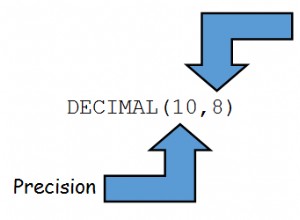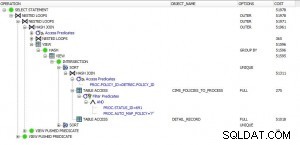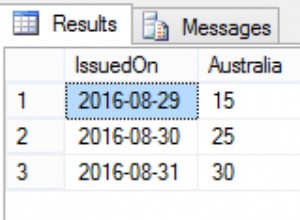Lo farei come una singola istruzione insert-as-select, complicata solo dal fatto che stai passando il nome_tabella, quindi dobbiamo usare sql dinamico.
Lo farei qualcosa del tipo:
CREATE OR REPLACE PROCEDURE some_name(p_table_name IN VARCHAR2,
p_chunk_size IN NUMBER,
p_row_limit IN NUMBER) AS
v_table_name VARCHAR2(32); -- 30 characters for the tablename, 2 for doublequotes in case of case sensitive names, e.g. "table_name"
v_insert_sql CLOB;
BEGIN
-- Sanitise the passed in table_name, to ensure it meets the rules for being an identifier name. This is to avoid SQL injection in the dynamic SQL
-- statement we'll be using later.
v_table_name := DBMS_ASSERT.ENQUOTE_LITERAL(p_table_name);
v_insert_sql := 'insert into chunks (common_column_name, chunk_number)'||CHR(10)|| -- replace the column names with the actual names of your chunks table columns.
'select common_column,'||CHR(10)||
' ora_hash(substr(common_column, 1, 15), :p_chunk_size) AS chunk_number'||CHR(10)||
'from '||v_table_name||CHR(10)||
'where rownum <= :p_row_limit';
-- Used for debug purposes, so you can see the definition of the statement that's going to be run.
-- Remove before putting the code in production / convert to proper logging code:
dbms_output.put_line(v_insert_sql);
-- Now run the statement:
EXECUTE IMMEDIATE v_insert_sql USING p_chunk_size, p_row_limit;
-- I've included the p_row_limit in the above statement, since I'm not sure if your original code loops through all the rows once it processes the
-- first p_row_limit rows. If you need to insert all rows from the p_table_name into the chunks table, remove the predicate from the insert sql and the extra bind variable passed into the execute immediate.
END some_name;
/
Utilizzando una singola istruzione di inserimento come selezione, stai utilizzando il modo più efficiente di svolgere il lavoro. L'esecuzione della raccolta in blocco (che stavi utilizzando) consumerebbe memoria (memorizzazione dei dati nell'array) e causerebbe cambi di contesto aggiuntivi tra i motori PL/SQL e SQL che l'istruzione insert-as-select evita.




